Using Rows and Swimlanes for OnePager Version 7.0
Contents
- 1 About Rows and Swimlanes
- 2 Creating Charts Using Rows and Swimlanes
- 3 Step 6 – Format Borders and Gridlines
About Rows and Swimlanes
1) This article introduces you to OnePager’s rows and swimlane management features.
2) Using rows and swimlanes is a common way to organize your chart so that task bars and milestone symbols in the rows can be grouped together in an organized fashion like a work breakdown structure.
Multiple Swimlane Level Feature
3) OnePager version 7.0 now supports three (3) swimlane levels version the one (1) swimlane level supported in previous versions. An example of a chart with three swimlane levels is shown below:
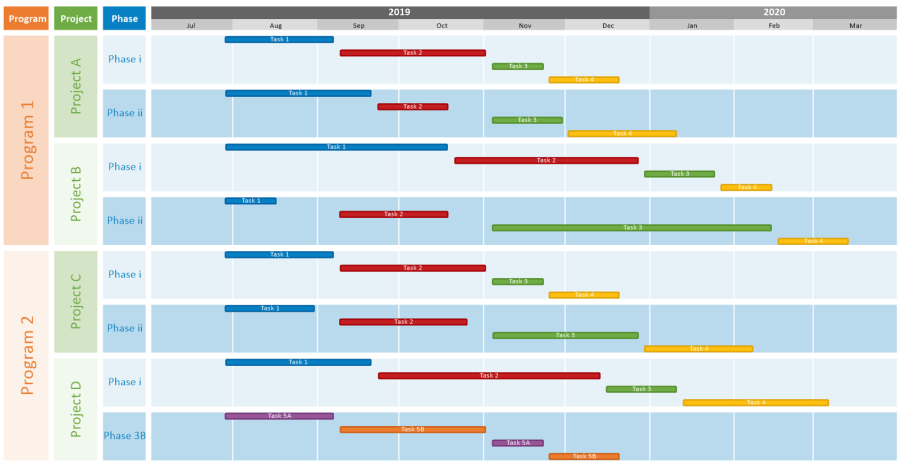
4) Supporting the new multiple swimlane level feature is a redesigned Template Properties and Chart Properties form's Rows/Swimlanes tab as shown below:
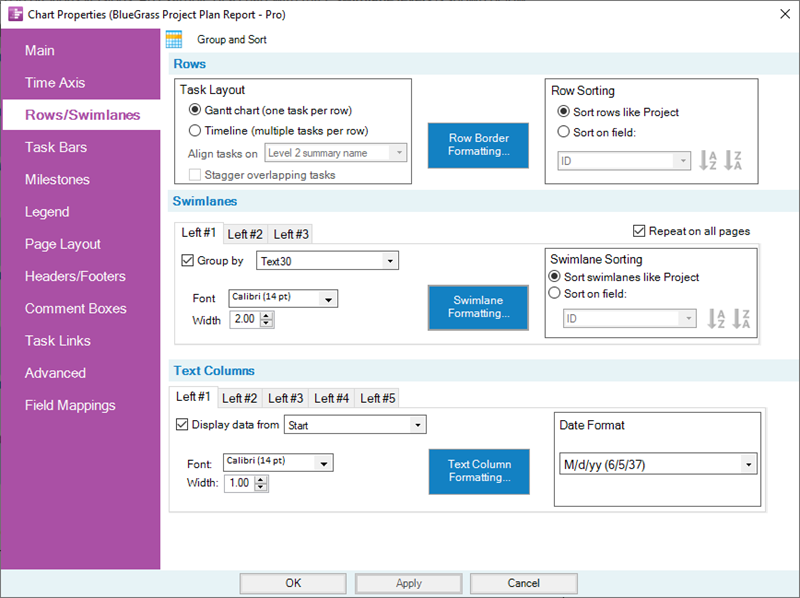
Schedule Presentation Considerations
5) It is always important to give consideration to your schedule presentation's goals and objectives and select the chart organization that best meets these goals and objectives.
6) If you are anticipating using one or more swimlane levels in a OnePager version 7.0 chart, the organization ans structure of the selected swimlane levels and the information the are to present are key decisions.
7) It may be that no swimlane levels need to be in the chart at all or that just one or two meets your needs.
8) Once the desired chart organization is determined, the steps below are provided as guidelines to creating the most beneficial chart.
9) The steps follow the organization of the Template Properties form and the Chart Properties form's Rows/Swimlanes tab such that you can start establishing your settings in the top control group and work your way through them from top to bottom left to right.
Creating Charts Using Rows and Swimlanes
1) As the Rows/Swimlanes tab above illustrates, there is a step wise approach to constructing an informative and useful OnePager Pro or Express chart.
2) The general methodology is for you to create or modify the chart by making setting determinations based upon the goals and objectives you intend to meet with your schedule conversation:
Step 1) Determine carefully how the chart is going to look - swimlane levels, text columns, the collection of task bars into chart rows, and the grouping of rows into the chart's swimlane levels.
Step 2') Determine how source plan tasks are going to be collected and sorted into chart rows. This determination includes
Step 3) Determine how chart's rows are going to be grouped into swimlane levels.
Step 4) Determine how many text columns are needed to adequately provide information from the source plan for the audience without making the chart too busy.
Step 5) Determine how row and swimlane borders are going to be formatted.
3) The five step process suggested above can be iterative as OnePager assists you in these steps because you can always go back to the Chart Properties form after a chart creation iteration and reassess your settings and how the chart communicates with respect to your goals and objectives.
4) The discussion that follows is divided into five (5) sub-sections, one each for the steps listed above.
Step 1 - Determine Carefully How the Chart is Going to Look
1) In majority of schedule presentation situations when you anticipate using multiple swimlane levels, the organization of the swimlane levels and their associated source plan fields you are going to use are straight forward.
2) When this is not the case, it is recommended that consideration be given to reviewing the goals and objectives of the schedule conversation where the chart is used and the information needs of members your audience.
3) Every schedule presentation situation is different so our suggestion is to spend some time in Step 1 to layout how you are going to address the remaining steps.
4) Adding swimlane levels and text columns can make the chart look busy and distract from the intended theme.
5) Too few swimlane levels and text columns may cloud the message you are trying to communicate.
6) The same logic applies to the determination of how many text columns to include in the chart.
7) Since there are three (3) swimlane levels, they appear in the chart from left to right as Left#1, Left#2, and Left#3 as shown in the Chart Properties form's Rows/Swimlanes tab above.
- a) The highest swimlane level in a chart is the left-most swimlane level and successively lower swimlane levels appear going to the right.
- b) This means that you are encouraged to place the highest organizational level of the chart in the left-most swimlane level and so on.
- c) Doing so avoids repeating swimlane level cells within a lower swimlane level cell which may make the chart confusing and distract from it communication value.
- d) It is also recommended to use as few swimlane levels as possible consistent with your schedule conversation message and the makeup of the audience.
8) After making these decisions, OnePager keeps track and provides consistent charts whenever you update your source plan and create an additional or modified snapshot.
Step 2 – Collect Source Plan Tasks into OnePager Chart Rows
1) Collecting source plan tasks into rows in the chart is usually done by selecting the Gantt chart layout where each chart row contains one task bar.
2) You have the option to use the Timeline layout where multiple task bars occupy one row in the chart.
Task Layout Sub-Control Group
3) The controls for making these settings are found in the Template Properties form or Chart Properties form at the Rows/Swimlanes tab's Rows control group's Task Layout sub-control group shown below:
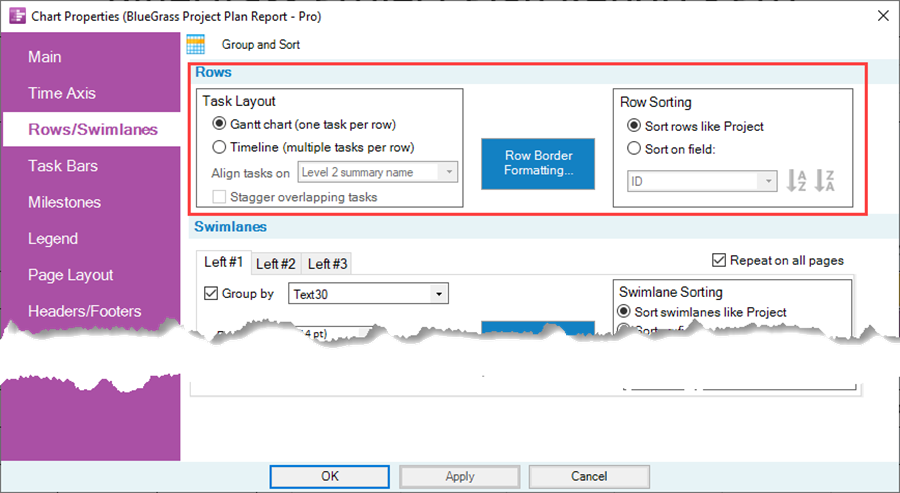
4) For more information on Task layout, please see the article at: TBD.
Row Border Formatting...
5) The Row Border Formatting... button accesses the Row Formatting form as shown below:
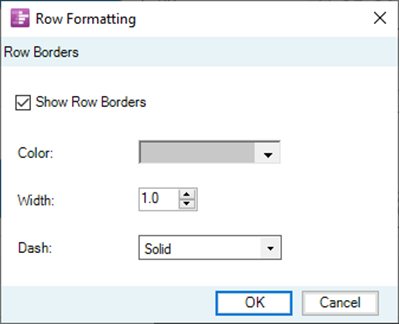
6) Row borders can be set at this point. However, we recommend setting row and swimlane level borders in Step 5 discussed below.
7) For more information on Row borders, please see the article at: TBD.
Row Sorting Sub-Control Group
8) Once the selection between Gantt chart and Timeline layout is made, you have additional controls over how rows are sorted.
9) Most OnePager users select the option to Sort rows like Project to maintain correspondence with their source plan organization.
10) Selecting the Sort on field: allows you to select a source plan field upon which to base the sorting of rows in the chart.
- a) Rows are sorted chart-wise if there are no swimlane levels present.
- b) When one or more swimlane levels are present in the chart, rows are sorted within the lowest swimlane level only.
- c) There are implications on sorting rows within the lowest swimlane level when there are task bars containing duplicate source plan field values in the set to be sorted.
11) For more information on collecting and sorting source plan tasks into OnePager chart rows, please see the article at: TBD.
12) After task bar collection into chart rows and the sorting of rows are determined, you can move on to determine how chart rows should be grouped into swimlane levels.
Step 3 – Group Chart Rows into Swimlane Levels
1) When the decision is made to incorporate swimlane levels in the chart as well as the number of swimlane levels you can use the Swimlanes control group in the Chart Properties form's Rows/Swimlanes tab to implement these decisions.
2) The Chart Properties form at the Rows/Swimlanes tab is shown below:
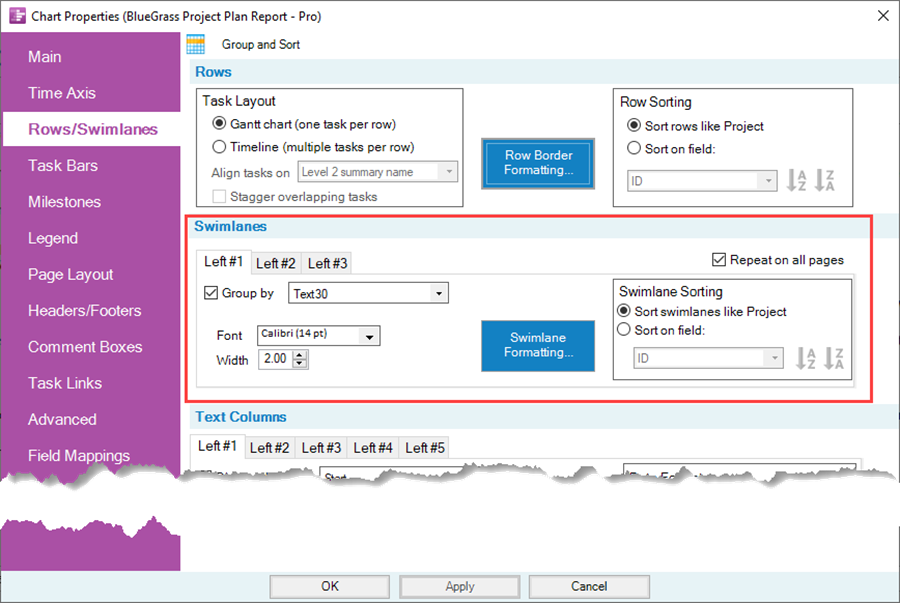
Swimlane Level Sub-Tabs
3) Each sub-tab shown above as Left#1, Left#2, and Left#3 are identical.
4) Checking the Group by checkbox ON in the sub-tab enables the swimlane level and the other controls in the sub-tab.
5) Use the window dropdown next to the Group by checkbox to implement your swimlane level decision with respect to how the chart's rows are grouped.
6) For more information on grouping chart rows into swimlane levels, please see the article at: TBD.
Swimlane Formatting...
7) You can now use the Swimlane Formatting... button to access the Swimlane Formatting - Left#n form to make settings pertaining to swimlane level heading cell labeling, swimlane level cell labeling, and swimlane level border settings as shown below:
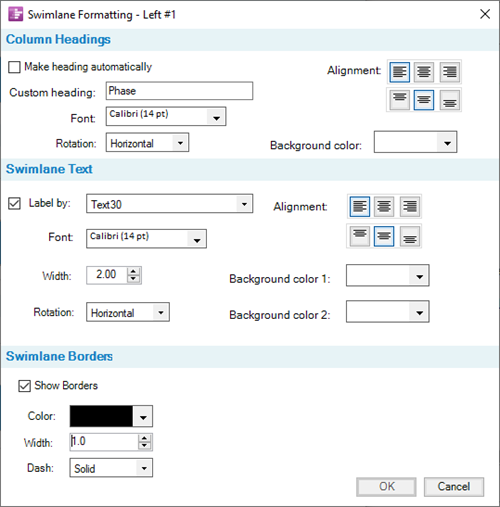
8) Note in the illustration above that the form's title includes the swimlane level number.
9) The Column Heading control group in the above form contains all the controls for allowing OnePager to set the swimlane level heading cell's label or to allow you to select the text content for this location in the chart.
10) Additionally, all the text formatting controls are provided in this sub-group.
11) The Swimlane Text control group shown above in the middle section of the form, contains all the controls for setting the swimlane level cell's labels within the swimlane level.
12) The Label by: checkbox must be checked ON for the swimlane level to be shown in the chart and for the other controls in this control group to be enabled.
14) As with the Column Heading control group, the Swimlane Text control group contains all the text formatting controls for the text content of swimlane level cells for level n in the chart.
15) The Swimlane Borders control group in the bottom section of the above form has all the controls for managing the borders associated with the swimlane level selected. However, we recommend setting row and swimlane level borders in Step 5 discussed below.
16) For more information on formatting swimlane components, please see the article at: TBD.
Swimlane Sorting Sub-Control Group
17) Swimlane sorting is done within swimlane levels involving all the rows found in the swimlane level.
18) There are two swimlane level sorting options: (1) Sort swimlanes like Project or (2) Sort on field.
19) Most OnePager users select the option to Sort swimlanes like Project to maintain correspondence with their source plan organization.
20) Selecting the Sort on field: allows you to select a source plan field upon which to base the sorting of swimlane levels in the chart.
- a) The options for sorting swimlane levels is only available if the swimlane level is showing in the chart.
- b) When one or more swimlane levels are present in the chart, rows are sorted within each swimlane level where sorting is to be performed by OnePager.
- c) Care should be exercised when sorting swimlane levels where there are multiple swimlane levels present in the chart.
21) For more information on sorting swimlane levels, please see the article at: TBD.
Step 4 – Determine Needs for Text Columns
1) There are five (5) optional Text Columns that you can place to the right of any shown swimlane levels and to the left of the graph.
2) Their purpose is to highlight information pertinent to row in the graph and the task bars and/or milestone symbols in the chart's row.
3) A typical example for the content of two text columns is to show task bar start date and finish date as illustrated in the partial chart below:
4) The controls for managing text columns are found in the Template Properties and Chart Properties form's Rows/Swimlanes tab at the Text Columns control group shown here:
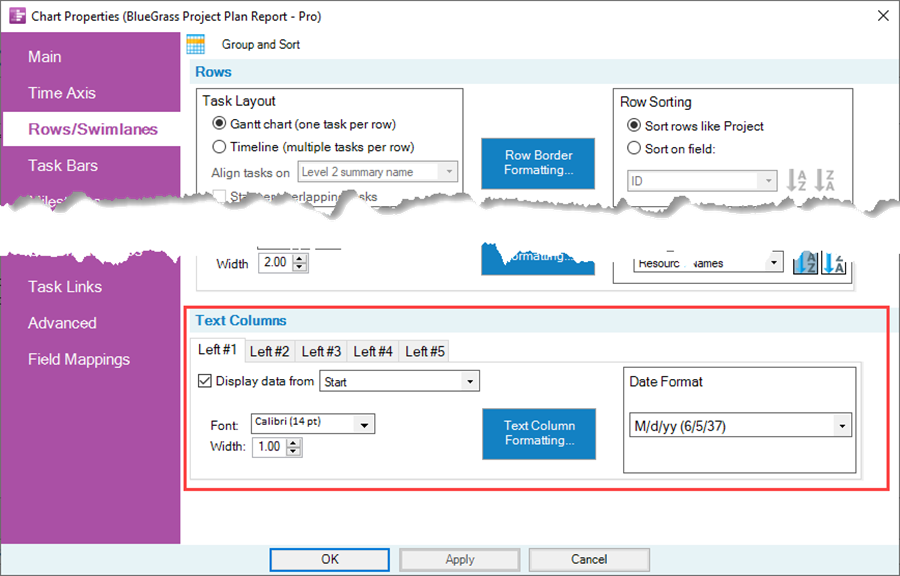
Text Columns Sub-Tabs
5) Each sub-tab shown above as Left#1, Left#2, Left#3, Left#4, and Left#5 are identical.
6) Checking the Display data from checkbox ON in the sub-tab enables the text column and the other controls in the sub-tab.
7) Use the window dropdown next to the Display data from checkbox to implement your text column decision with respect to the source plan data for the task bar or milestone symbol that is displayed.
8) For more information on text columns, please see the article at: TBD.
Text Column Formatting...
9) You can now use the Text Column Formatting... button to access the Text Column Formatting - Left#n form to make settings pertaining to text column heading cell labeling and text column cell labeling settings as shown below:
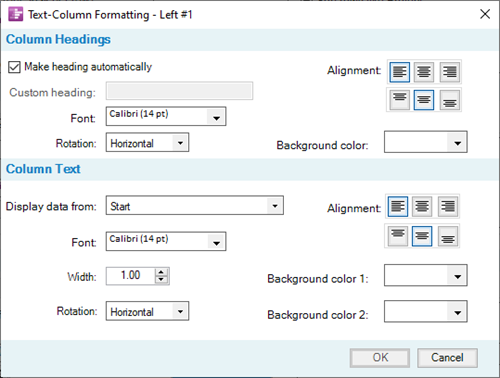
10) Note in the illustration above that the form's title includes the text column number.
11) The Column Heading control group in the above form contains all the controls for allowing OnePager to set the text column heading cell's label or to allow you to select the text content for this location in the chart.
12) Additionally, all the text formatting controls are provided in this sub-group.
13) The Column Text control group shown above in the bottom section of the form, contains all the controls for setting the text columns cell's labels within the text column.
14) As with the Column Heading control group, the Column Text control group contains all the text formatting controls for the text content of text column cells for level n in the chart.
15) There are no border controls in this form as text columns are consider part of a chart's row and the controls for row borders are contained in the Rows control group of the Chart Properties form's Rows/Swimlanes tab.
16) For more information on formatting text columns, please see the article at: TBD.
Text Type Formatting for Date and Numeric Formats
17) When a text column's designated source plan field is a date type field, the Text Columns sub-group in the main form has an additional sub-group added to allow you to edit the date field as it appears in the text column cells. This is shown in the above illustration for the Chart Properties form's Rows/Swimlanes tab.
18) When a text column's designated source plan field is a numeric type field, the Text Columns sub-group in the main form has an additional sub-group added to allow you to edit the numeric field as it appears in the text column cells. This is shown in the illustration below:
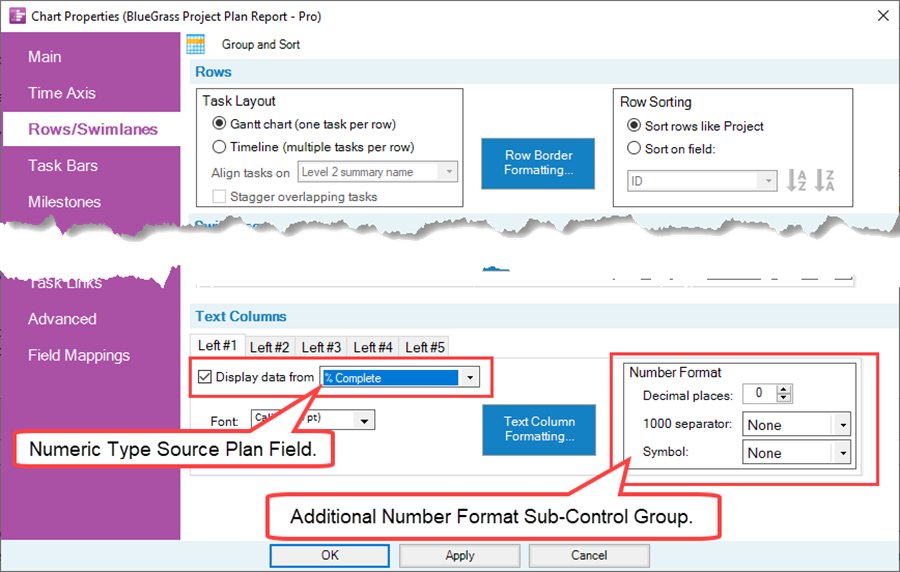
19)
Step 6 – Format Borders and Gridlines
1) As the final step in preparing your rows and swimlanes presentation, you may choose to turn on the row and swimlane borders feature.
2) This feature allows you to exercise control of borders around rows, around swimlanes, the inner frame of the chart, and the outer frame of the chart as detailed in the next sub-section.
Format Borders
3) When the Format Borders button is clicked, a form consisting of five (5) tabs is presented that allows you to control gridline color, width, and dash type.
4) The tabs are shown below and apply to:
- a) Swimlane borders
- b) Row borders
- c) Time cursor borders
- d) Inter frame borders
- e) Outer frame borders
4) Border commands for color, width, and dash type are as consistent as possible with those found in Microsoft Excel.
Swimlane borders, Row borders, Time cursors, Inner Frame and Outer Frame Common Controls
5) By clicking the Format borders… button in the Chart Properties form's Rows and Swimlanes tab you can configure borders for rows, swimlanes, and the other elements as shown below.
- a) Line color This dropdown list provides a color palette from which the line color for the border can be selected.
- b) Line width The line width for all borders is in units of font points.
- c) Dash type There are five (5) line or dash types available for borders which include: (1) Solid, (2) Dot, (3) Dash, (4) Dash dot, (5) Dash dot dot.
- d) Border type: There are three (3) border types available which include: (1) Above, (2) Below, (3) Both.
6) The four controls mentioned above are consistently used for three (3) of the five borders tabs.
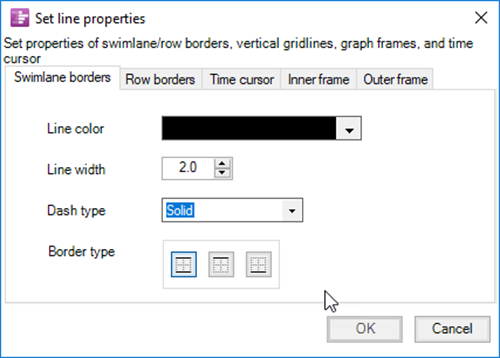
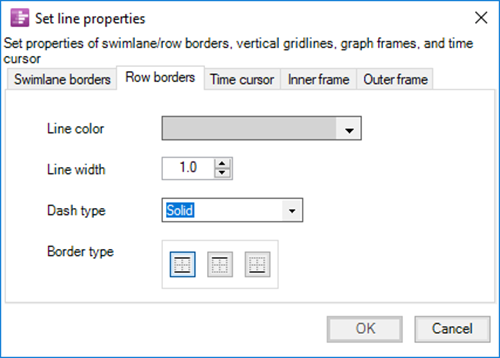
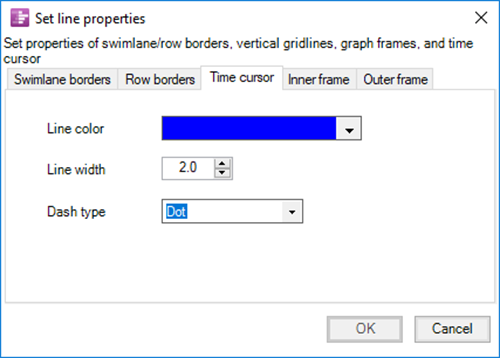
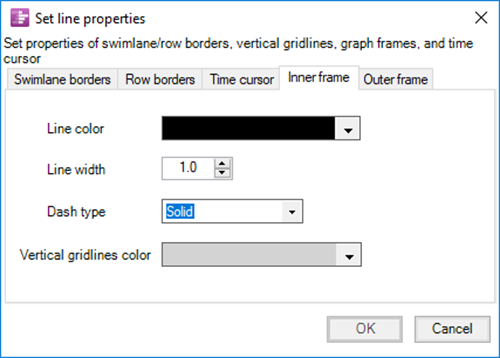
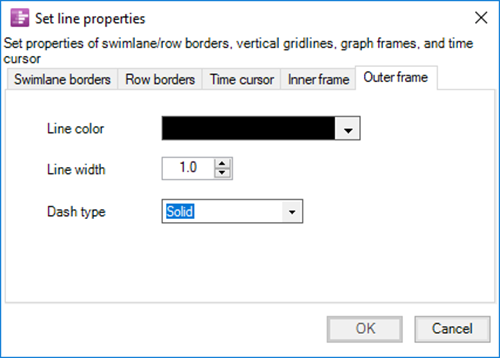
Vertical Gridlines Color
7) The Inner frame tab has an additional control for the color of the vertical gridlines.
8) Vertical gridlines are shown to place time separations on the graph.
9) Typically vertical gridlines are used to place separation between years or other major time boundaries.
10) The Inner frame tab below shows this control.
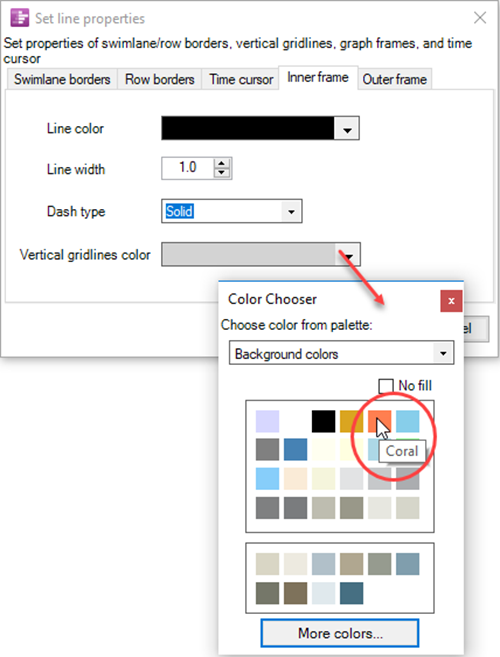
Example of Vertical Gridlines
11) The following segment of a chart illustrates the use of vertical gridlines:
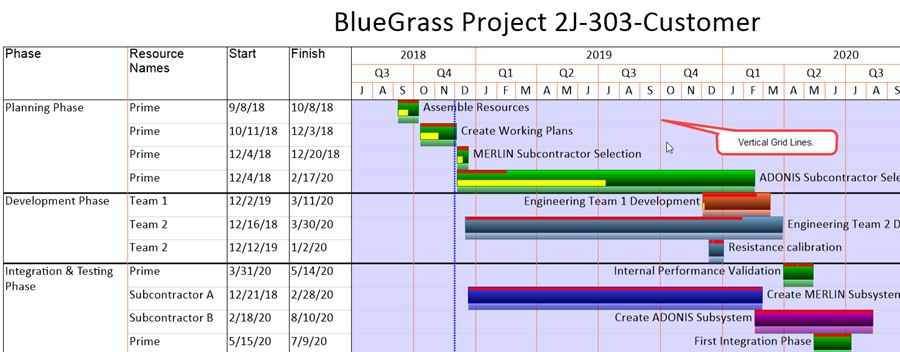
(4.0.1.5-70)